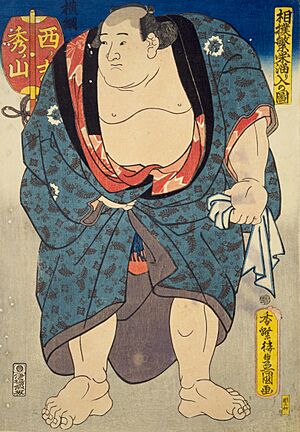Hidenoyama Raigorō facts for kids
Quick facts for kids Hidenoyama Raigorō |
|
|---|---|
| 秀ノ山 雷五郎 | |

Woodblock print of Hidenoyama by Kunisada, circa 1850
|
|
| Personal information | |
| Born | Kikuta Tatsugorō 1808 Kesennuma, Mutsu, Japan |
| Died | June 16, 1862 (aged 54) |
| Height | 1.64 m (5 ft 5 in) |
| Weight | 135 kg (298 lb) |
| Career | |
| Stable | Sekinoto → Hidenoyama |
| Record | 112-21-96 33draws-2holds (Makuuchi) |
| Debut | March, 1828 |
| Highest rank | Yokozuna (September 1847) |
| Retired | March, 1850 |
| Elder name | Hidenoyama |
| Championships | 6 (Makuuchi, unofficial) |
| * Up to date as of October 2007. | |
Hidenoyama Raigorō (秀ノ山 雷五郎, 1808 – June 16, 1862) was a famous Japanese sumo wrestler. He came from Kesennuma, a place in Japan. He became the 9th yokozuna, which is the highest rank in sumo.
Contents
Hidenoyama's Sumo Career
Hidenoyama was born Kikuta Tatsugorō (菊田 辰五郎). He later changed his family name to Hashimoto. He wanted to become a rikishi (sumo wrestler) because his older brother was already an ōzeki, a high-ranking wrestler.
In 1823, he tried to join Sekinoto stable. But the master, Arakuma Rikinosuke, ignored him. Hidenoyama was very short, only about 1.51 meters (5 feet) tall. He was only allowed to do chores and couldn't train.
In 1827, he joined Hidenoyama stable, led by the ōzeki Genjiyama. He made his official debut in March 1828. His first ring name, or shikona, was Kitayama Tatsugorō (北山 辰五郎).
He wrestled for the Matsuidara clan for a while. His shikona then became Amatsukaze Kumoemon (天津風 雲右衛門). Later, he was called Tatsugami Kumoemon (立神 雲右衞門) and reached the rank of ōzeki.
In 1844, he became ōzeki again. He changed his shikona twice more. First, he was Iwamigata Jōemon (岩見潟 丈右衞門). Then, he took his master's name, Hidenoyama Raigorō (秀ノ山 雷五郎).
Becoming a Yokozuna
Hidenoyama received his yokozuna license in September 1845. This license came from the Yoshida family, who were very important in sumo. At 1.64 meters (about 5 feet 4 inches), he was the shortest yokozuna ever.
He wasn't always seen as the strongest wrestler of his time. But he had powerful supporters. Some even said he was like a member of the Yoshida family. Another ōzeki, Tsurugizan Taniemon, reportedly gave Hidenoyama his yokozuna license.
Retirement and Legacy
Hidenoyama retired from sumo in March 1850. He was 54 years old. Even after retiring, he continued to perform the yokozuna ring-entering ceremony until 1861.
He had an amazing record of 30 wins in a row. He also won the equivalent of six championships. Back then, there wasn't a modern championship system like today. In the top Makuuchi division, he won 112 matches and lost only 21. This means he won 84.2% of his fights!
After retiring, he became a sumo elder, still known as Hidenoyama. He trained two future sumo stars: yokozuna Jinmaku and ōzeki Ayasegawa. Hidenoyama passed away in June 1862. Another wrestler, Kasagiyama, then took on the name Hidenoyama.
The "Kaei Turmoil"
Hidenoyama also served as a judge (called naka-aratame back then). This job gave him a lot of power. People said he sometimes made decisions that favored his own students.
At that time, many lower-ranked wrestlers wanted to have more sumo matches. Hidenoyama had the power to decide who got to wrestle. He often said no to other wrestlers, but allowed his own students to compete more.
The other wrestlers got very angry. They accused him of being unfair. In 1851, they went on strike! This was the first time sumo wrestlers had ever walked out. This event is now known as the 'Kaei turmoil'. In the end, Hidenoyama apologized to the wrestlers.
Fighting Style
Hidenoyama was not always good at wrestling against very skilled opponents. But he worked incredibly hard. He used his training to make up for his smaller size and round shape. People said he had a very strong fighting spirit.
Homage
There is a large bronze statue of Hidenoyama in Kesennuma, Japan. It weighs 10 tons and stands at the entrance of the bay. In 2011, a huge earthquake and tsunami hit Japan. The statue survived and became a symbol of strength and hope for the area.
See also
- Glossary of sumo terms
- List of past sumo wrestlers
- List of yokozuna

